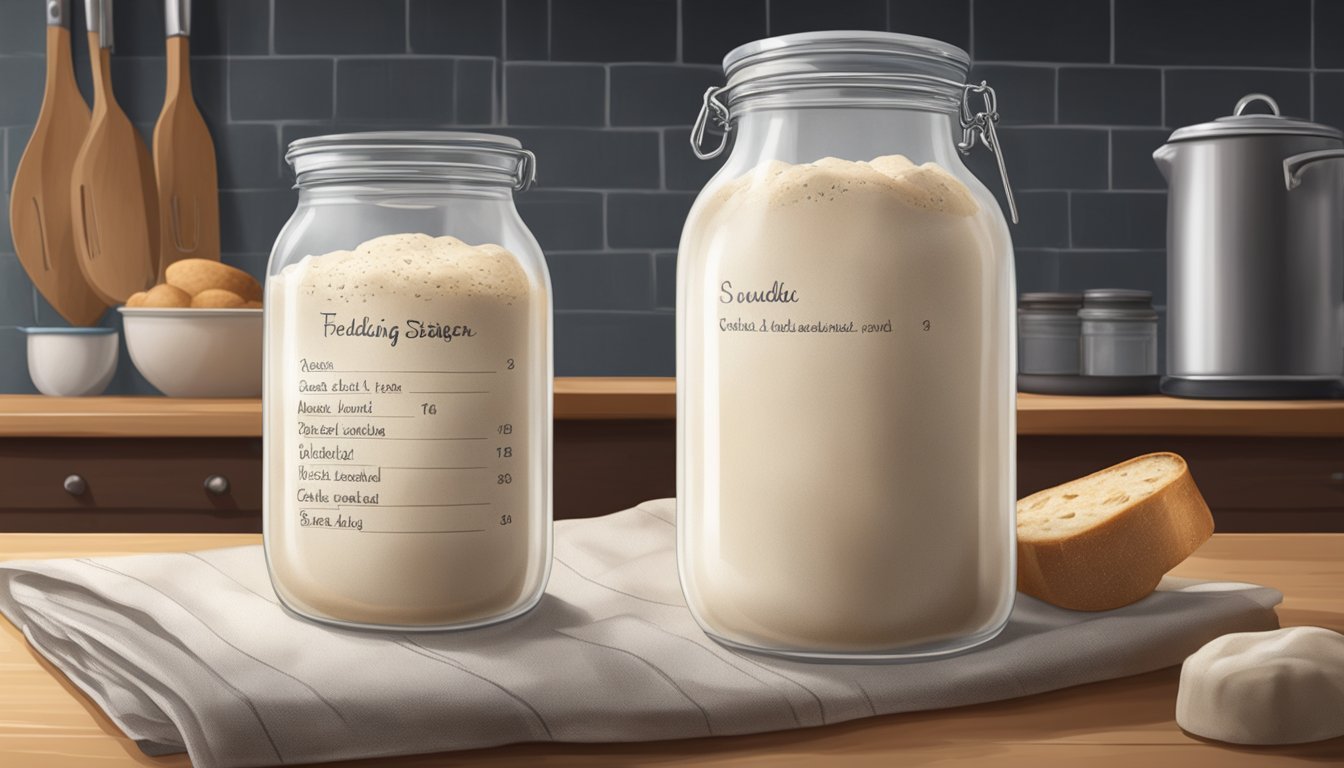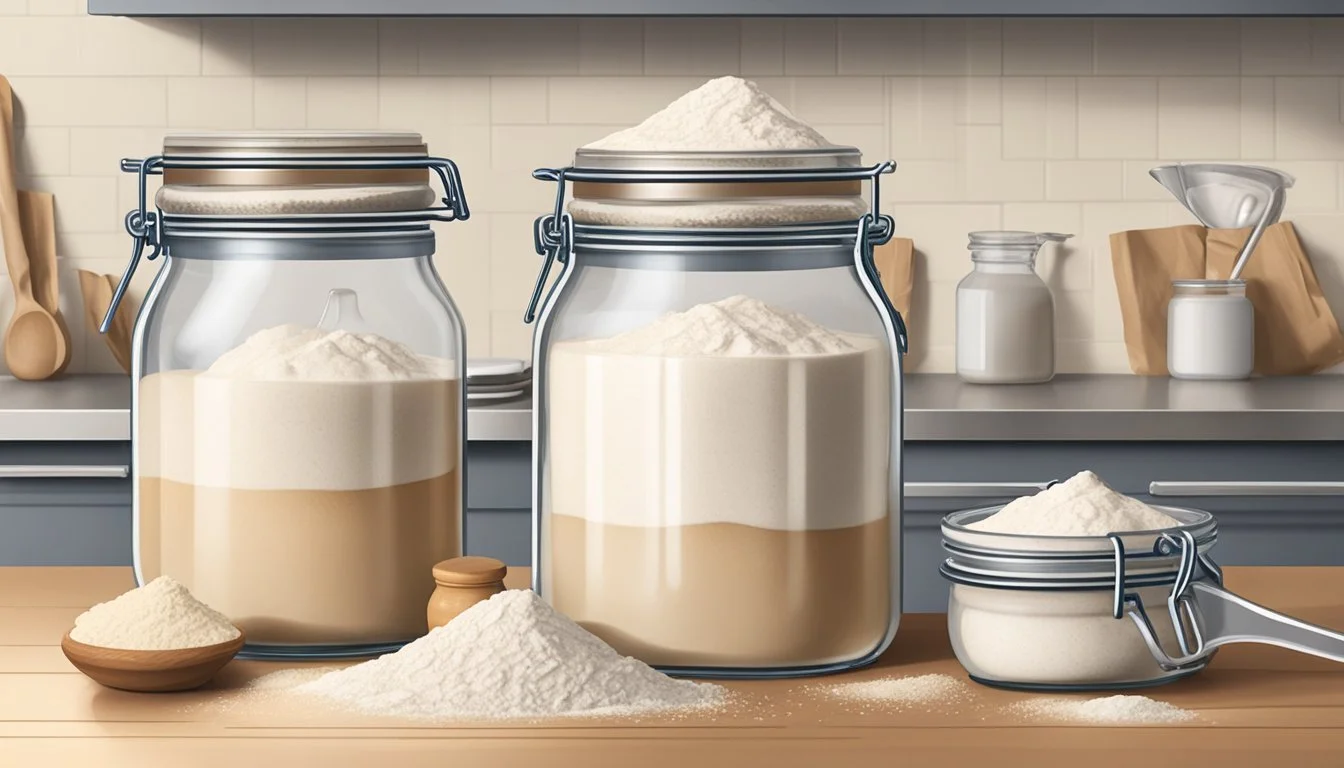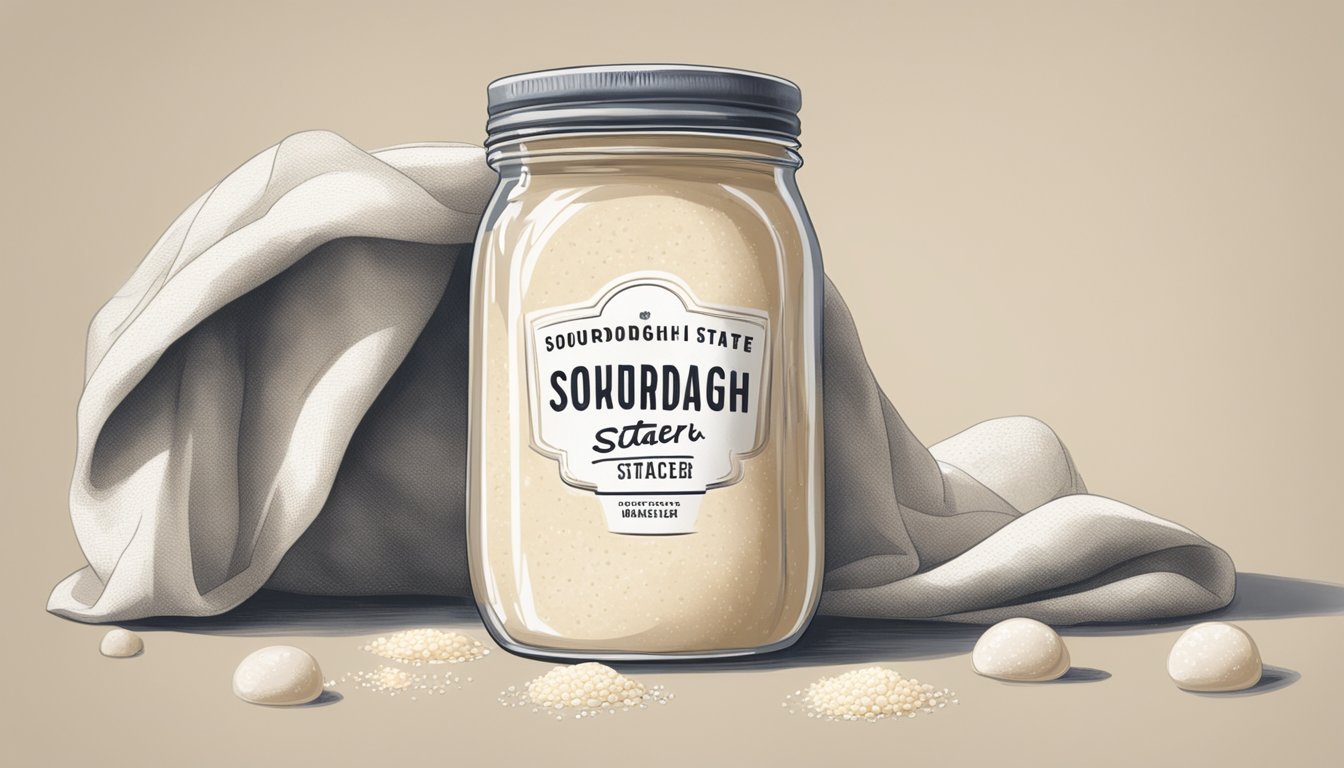How Long Does Sourdough Starter Last?
Shelf Life and Storage Tips
A sourdough starter's longevity is an intriguing aspect of home baking, challenging the notion of perishable ingredients with its persistent vitality. Essentially a living colony of natural yeast and bacteria, a sourdough starter has the remarkable ability to last almost indefinitely with the proper care. It achieves this through a symbiotic relationship between the microorganisms, which ferment the flour and water mixture, enabling it to be used repeatedly for baking.
The key to a starter's endurance lies in its maintenance. Regular feeding, which entails adding fresh flour and water, keeps it active and healthy. In active use, the starter can be kept at room temperature and fed daily. For less frequent use, it can reside in the fridge, where it requires feeding only once every week or two. These simple practices ensure that the starter remains a robust and ever-ready ingredient in the baker's kitchen.
Left in the fridge, a sourdough starter undergoes changes over time. It may develop a layer of liquid known as 'hooch' which can be stirred back in or poured off. Its appearance and aroma might evolve, but these are not indicators of spoilage. In fact, a well-maintained starter can be a perpetual source of leaven, only improving with age as it develops deeper flavors, making each baked loaf unique and characterful.
Fundamentals of Sourdough Starter
In the realm of baking, the sourdough starter is the foundational element that leads to the creation of flavorful and artisanal bread (What wine goes well with bread?). It is a living entity, requiring care and understanding for optimal performance.
What Is Sourdough Starter?
Sourdough starter is a mixture of flour and water that has been inoculated with wild yeast and lactic acid bacteria from the environment. These microorganisms initiate fermentation, which not only causes the bread to rise but also contributes to its characteristic tangy flavor. A healthy starter is a symbiotic culture where yeast and bacteria coexist, with the yeast contributing primarily to leavening and the bacteria contributing to flavor and strengthening of the dough.
Understanding the Components
Yeast: Wild yeast, present in the sourdough culture, is responsible for the leavening process. Unlike commercial yeast, wild yeast in a starter works slower and imparts a distinct flavor to the bread.
Lactic Acid Bacteria: These bacteria are essential for the sourdough's distinctive taste. They produce lactic acid during fermentation, contributing to the complex, tangy flavor profile of sourdough bread.
Flour: Serves as the primary food source for the yeast and bacteria in the starter. The types of flour used can alter the flavor and activity of the culture.
Water: Hydrates the flour, enabling the microorganisms to become active. The water-to-flour ratio influences the starter's hydration level, which affects fermentation activity and the final bread texture.
In maintaining a starter, bakers must regularly "feed" it with fresh flour and water to keep the microorganisms active and healthy, thus ensuring a consistent rise and flavor in their sourdough bread.
Creating and Maintaining a Healthy Starter
A healthy sourdough starter relies on a balanced feeding routine and proper maintenance. Bakers must be diligent in observing and maintaining the health of their starter, with frequent feeding and refreshing to keep it active and vibrant.
Feeding Your Starter
To feed a sourdough starter, one should combine equal parts starter, flour, and water by weight. For instance, one might mix 113 grams of starter with 113 grams of water and 113 grams of flour. This mix is then allowed to ferment until the next feeding.
The Feeding Schedule
Frequency: A starter should be fed regularly, with the exact schedule depending on its environment. At room temperature, daily feeding is ideal. In contrast, a refrigerated starter can be fed once a week. Ratio: Typically, a ratio of 1:1:1 for starter, water, and flour is suitable. Adjustments can be made based on the desired hydration level of the starter.
Discarding Excess Starter
Before each feeding, it is customary to discard a portion of the starter. This can be done by removing all but roughly 20 grams of the existing starter. The discard can be used in various recipes or disposed of if necessary.
Identifying Signs of a Healthy Starter
A healthy sourdough starter should exhibit a pleasant aroma, akin to ripe fruits or beer, and show consistent growth after feeding. It should have a balance of lactic and acetic acids. The presence of bubbles and a foamy texture indicates that adequate fermentation is occurring.
Storing Sourdough Starter
Proper storage of sourdough starter is crucial for its viability and longevity. The starter can be stored short-term at room temperature or for extended periods in colder environments, like a fridge or freezer.
Short-Term Storage Options
For bakers who use their sourdough starter regularly, room temperature storage is sufficient. They should keep the starter in an airtight container to protect it from contaminants. After feeding, they should allow the starter to sit at room temperature for about 2-3 hours to become active before storing. It's best to store the starter in a glass jar or container for easy monitoring. Daily feeding is required to maintain a healthy culture when stored this way.
Long-Term Storage Solutions
When storing sourdough starter for long periods, the refrigerator is their ally. They can feed their starter, let it rest to begin fermentation, and then place it into the fridge. This slows down the fermentation process, meaning the starter only needs feeding once a week. For even longer storage, they could spread a thin layer of active, bubbly starter onto parchment paper, let it air dry for 24 hours, then store it in an airtight container. This dried starter can be reactivated with water and flour when ready to use.
Maximizing Sourdough Starter Lifespan
To ensure a sourdough starter maintains its vitality, one must understand the proper storage techniques, as well as how to freeze and revive it. Care and consistency are key components in extending a sourdough starter's lifespan.
Optimal Storage Conditions
Sourdough starter thrives at room temperature when it's actively used. For daily bakers, keeping the starter on the counter and feeding it once a day is ideal. Feeding involves discarding part of the starter and replenishing it with fresh flour and water. When less frequent use is anticipated, the starter should be sealed and placed in the fridge. In this cooler environment, it only requires feeding once a week, limiting its exposure to air and slowing down yeast activity, thus preserving its potency.
Room Temperature Storage: Feed daily, keep covered on the counter.
Refrigerated Storage: Feed weekly, seal tightly before refrigeration.
Freezing Your Starter
Long-term storage can be achieved by freezing the starter. This process halts yeast activity but doesn't kill it. To freeze, one should first spread a thin layer of active starter on a piece of parchment paper to dry. Once dried, crack the layer into flakes and store in a freezer-safe container, effectively preventing freezer burn. The starter can safely remain in the freezer for several months.
Dry the Starter: Spread on parchment, air dry for 24 hours.
Store in Freezer: Place dried flakes in an airtight container.
Reviving a Dormant Starter
Reviving a starter from the fridge or freezer involves returning it to room temperature and feeding it regularly until it shows consistent activity. An unfed starter from the fridge may need a few feedings over consecutive days to regain strength. A starter from the freezer should be allowed to thaw at room temperature before feeding. A neglected sourdough starter might take longer to revive, and one should look for signs of life such as bubbling and a pleasant, yeasty aroma as indicators of success.
Revive from Fridge:
Thaw, if necessary.
Feed every 12-24 hours until active.
Revive from Freezer:
Thaw completely.
Feed with flour and water, wait for bubbles.
Using Your Sourdough Starter
When maintaining a sourdough starter, the goal is to keep it active and healthy for baking a variety of sourdough-based products. The starter consists of a mix of flour and water, which harnesses natural yeasts and bacteria to create the leavening needed for sourdough baking. Proper handling ensures the starter is ready for use in various recipes.
Baking with an Active Starter
To bake sourdough bread, an active sourdough starter is essential. It should be bubbly and should have been fed with flour and water recently to ensure its potency. An active starter contributes to the bread's rise, texture, and flavor:
Feeding: Prior to baking, feed the starter to ensure it's active. This usually means adding equal parts of flour and water.
Testing: Drop a spoonful of the starter into water; it should float if it's ready for bread-making.
Mixing: Combine the starter with flour, water, and salt according to the recipe.
Proofing: Allow the dough to rise, which may take several hours.
Baking: Bake the dough in a preheated oven following the guide for sourdough baking.
Non-Bread Recipes
One can use a sourdough starter in a range of non-bread recipes to add a tangy flavor and use excess starter. Pancakes, waffles, cakes, and pizza dough can all be made with a sourdough starter:
Pancakes and Waffles: Use the starter to create a batter, adding ingredients like milk, eggs, and a leavening agent such as baking powder.
Cake: Incorporate the starter into cake recipes for a unique twist.
Pizza Dough: Combine the starter with flour, water, and salt for the crust, then add preferred toppings.
A sourdough starter is not just for bread; it's a versatile ingredient that enhances several recipes across different cuisines.
Troubleshooting Common Issues
When maintaining a sourdough starter, it is vital to monitor for mold and manage its smells and liquids to ensure a healthy fermentation process.
Preventing and Dealing with Mold
If a starter has visible signs of mold or develops an orange or pink tint, it indicates contamination. Prevent mold by storing the starter in a clean container and keeping it in an environment with a stable temperature. To deal with mold, one should discard the contaminated starter and begin a new one, as mold cannot be safely removed from the starter.
Addressing Unusual Smells and Liquids
A sour or vinegar smell often means the starter is hungry and requires feeding with fresh flour and water. Hooch, a layer of liquid that can appear on a starter, indicates fermentation but may also suggest that the starter needs feeding. Stir the hooch back in if a more sour flavor is desired, or pour it off to adjust consistency and continue with regular feeding.
Additional Resources and Techniques
To master the art of sourdough baking, one may benefit from a plethora of guides and advanced techniques available through various mediums. These resources offer valuable tips and step-by-step instructions that can help both beginners and experienced bakers.
Sourdough Starter Guides
A comprehensive sourdough starter guide is the cornerstone for anyone looking to delve into the world of natural-leavened baking. Such guides typically cover:
Creating a Starter: Step-by-step process using a blend of all-purpose flour and water, with options to incorporate whole wheat or rye flour for added complexity.
Maintenance Tips: Techniques on feeding, storing, and understanding the visual cues that indicate a healthy sourdough starter.
Troubleshooting: Advice for common issues, such as off smells or inconsistent rising, to ensure the starter remains viable.
Readers may find printed cookbooks or trusted online platforms like "The Perfect Loaf" for detailed information and guidance on maintaining a sourdough starter.
Advanced Baking Techniques
For those who seek to refine their baking skills, exploring advanced baking techniques can elevate their bread-making to new heights. These strategies include:
Flour Variations: Utilizing different flour types, such as rye or whole wheat, to alter texture and flavor.
Hydration Levels: Adjusting water content to impact the dough's consistency and the final crust of the bread.
Baking Environment: Manipulating temperature and humidity to achieve the perfect rise and crust.
Videos on platforms like YouTube can showcase these techniques in action. Expert bakers often share their secrets, allowing viewers to see exactly how to handle the dough and assess its readiness for the oven.
Conclusion
A sourdough starter's lifespan is impressive—it can last indefinitely with proper care and regular feedings. The key to maintaining a healthy starter lies in the balance of its storage environment and feeding routine.
In the Refrigerator:
A sourdough starter stored in the fridge requires feeding once or twice a week.
Storage longevity affects its appearance and aroma; the starter may become less appealing over time but can still remain active.
At Room Temperature:
If used daily, the starter should be kept at room temperature and fed accordingly, typically once a day.
Feeding Guidelines:
A common practice includes discarding all but 20 grams of the starter, then adding flour and water.
Ratios vary, but an example feeding involves 70 grams of white flour, 30 grams of whole rye flour, and 100 grams of water.
Maintaining a starter includes observing changes and adjusting the feeding schedule if necessary, based on its activity and the baker's usage patterns.
It should be highlighted that a well-attended sourdough starter has the potential to provide countless loaves of character-rich bread, embodying unique flavors cultivated over time. This resilience reinforces the starter's position as a cherished element in both historical and contemporary baking practices, emphasizing that the responsibility bestowed upon the baker is as crucial as the ingredients themselves.









